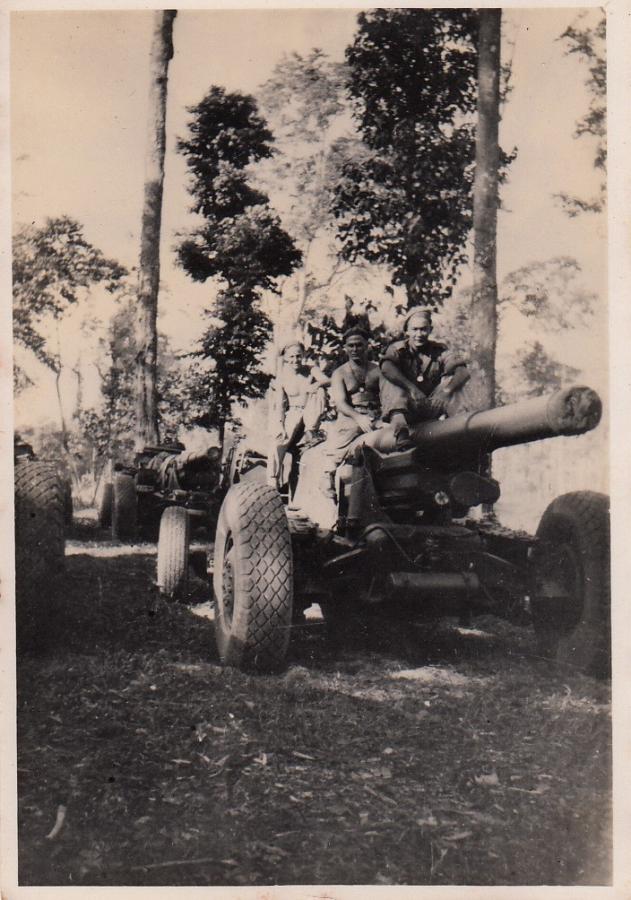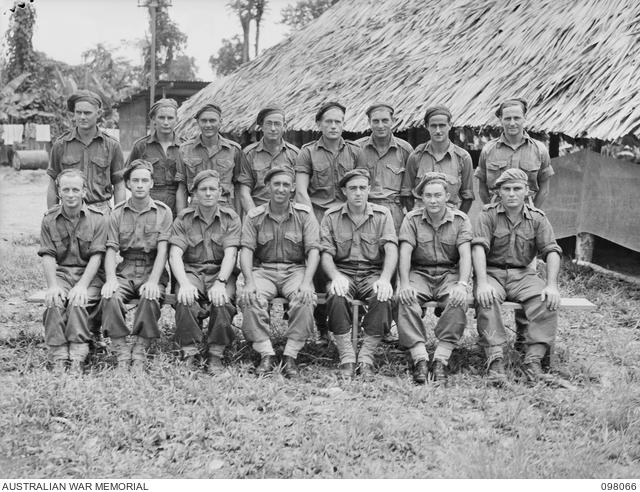'It was a terrible time'

Len Seto pictured during the war. Photo: Courtesy Len Seto
There are some things Len Seto would rather forget, but the memories are never far away.
Now 100 years old, Len was a signalman in New Guinea and Bougainville during the Second World War.
He had just turned 22 and was on a boat to Bougainville when a storm hit in May 1945.
“I was a wireless operator in the Royal Australian Signal Corps and we were attached to a 25-pounder artillery regiment,” Len said.
“There wasn’t enough room. They were only small boats, only a couple of hundred tonnes, like little fishing boats they really were …
“They were recruited from everywhere – from the Yanks, from Australia – to be used as transports, and all the 25-pounder guns were stored down in the hold.
“We had to sit up on deck, and so a couple of hundred of us were stuck up on deck, and ... the first night out there was this storm.
“The storm was so bad they threw ropes at us and told us to tie ourselves to the railing so that we wouldn’t be washed over.
“That was a bit of a hairy night that we had there.
“I can't say in normal language what we felt like ... but we were very scared, I can tell you that.
“But then we went into action. So which was worse? Getting washed overboard and getting drowned or getting shot at. Take your pick.”

Len was a signalman attached to an artillery regiment during the war. Photo: Courtesy Len Seto
It was a world away from Len’s life as a waiter before the war.
The third son of Ikutaro Seto and his wife Elizabeth, Leonard Seto was born in Brisbane on 11 April 1923. His father had emigrated from Japan in the 1890s and his mother had emigrated from Ireland.
By the time Japan entered the war in 1941, Len was working as a silver service waiter in New Farm.
Len enlisted on 10 December 1941, three days after the Japanese bombing of Pearl Harbour. The then 18 year old was given the service number QX 39496. The “X” meant he was a volunteer, a fact he has been proud of his entire life.
“I was working in hotels at the time,” Len said. “And I wanted adventure – and also a bit of peace actually, because being half Japanese, I got into a hell of a lot of fights.
“You can imagine what it would be like, being in the army, fighting the Japanese. And I was Japanese ... It wasn’t a very happy time.”
Len’s older brothers – Donald and Keiran – also served during the war. Donald, a cost clerk, went on to serve with the Second Australian Imperial Force in New Guinea, Morotai and Labuan. While Keiran, a public servant, served with the Citizen’s Military Force in the Northern Territory and Queensland.

Len and his best mate Les Kaus as new recruits. Photo: Courtesy Len Seto
Len was attached to the 17th Field Regiment and served in Townsville as part of York Force. Japanese flying boats had made three attacks on the town and the harbour in July 1942. Two of the three attacks involved a single aircraft, commanded by Sub Lieutenant Mizukura Kiyoshi. The aircraft’s bombs fell harmlessly into the harbour or onto the ranges behind the town. The last bomb of the final raid landed at the racecourse, breaking windows in nearby houses.
“Townsville was a garrison city and the town was full of soldiers ... Americans and us,” Len said.
“It was all completely blacked out – no lights allowed – and ... they missed the town completely which was ... very lucky for everybody.”
Len then served with a signals section attached to the 5th Field Regiment in Darwin. Japanese forces had bombed the town on 19 February 1942. It was to be the first of 64 raids on Darwin between February 1942 and November 1943.
“We were camped at Larrakeyah Barracks ... right up on top of the hill, just outside of the main town of Darwin,” Len said.
“They really came right over the top of it and just about obliterated Darwin.
“There wasn’t much left of it at all ... They just about flattened the town.”
In September 1944, Len embarked for service in New Guinea aboard the troopship, Katoomba.
“They told us, ‘You’re going overseas,’ and boomf, away you went,” Len said.
“The first night out from Darwin we were all sleeping on the deck because it was too hot to go down into the holds ... going into the tropics.
“Then in the morning, when we woke up, we were going westward, and we said: ‘This isn’t right ... We’re supposed to be going over to New Guinea.’
“And then we found out these Japanese submarines were chasing us all night, trying to get us, so we were zooming around in circles and our destroyers were out trying to protect us, so that was a bit of fun.”
Len went on to serve in the Markham Valley before heading to Bougainville.
More than 70 years later, he can still remember some of the codes he used there as a signalman.
“The Sigs are the heart of the army,” Len said.
“Without the Sigs, there can't be any army because of the communications between units and that.
“I was in headquarter signals and we had to maintain contact between the three batteries in the regiment and with army headquarters to get the orders about what we were supposed to be doing, where we were supposed to be going.
“In Sigs, everybody had to do be able to do everything in case whoever got knocked over and you had take their job. So you had to be able to ride a bike, drive a truck, use the telephone, and use the wireless, and know Morse code and all that type of thing.
“The humidity in the air ... would interfere with the radios, and the telephones too, so you had to keep them dry and wipe them down.
“They used to get damp and not function properly, so it was a constant job to keep everything dry and keep them operating properly.”
He was in Bougainville when he learnt the war was finally over.
“I was on Sig office duty at the time,” Len said. “And somebody from headquarters, way back down the line, rang ... on the radio, and they said, ‘It’s over, they’ve surrendered.’
“And we were getting shot at at the time. Bullets were flying everywhere and I said some nice choice words, and told them, ‘How about telling these people up here that it’s all over and to stop trying to kill us.’
“So that was my first news that the war was over – being shot at.”
After the war, Len was sent to Rabaul in New Britain to help guard Japanese prisoners of war and supervise their repatriation.
He returned to Australia and was discharged in May 1946. He took up one of the repatriation opportunities offered to ex-servicemen after the war as part of the Commonwealth Reconstruction Training Scheme and became a professional signwriter and then a TAFE teacher, writing a technical course on signwriting and screen-printing.
He also took up painting to help him cope with what he had experienced during the war. Today his artwork lines the length of his home.
“Nobody that hasn’t been in the army or in actual action knows what it’s like,” Len said.
“You can’t imagine it, unless you were there.
“New Guinea was horrible. It was just complete jungle where we were.
“At times, you couldn’t see more than two metres away from yourself ... and they were always hiding in there waiting for us, so it was a bit scary ...
“But then they sent us over to Bougainville. And that was the worst of the lot ...
“That’s why I came back with a few grey hairs and what they call now, post-traumatic stress disorder.”

Torokina, Bougainville, October 1945: Personnel of the 2/11th Field Regiment Signal Section. Len is pictured, front row, second from the right.
Len took up ballroom dancing after the war to help with his PTSD. It was there that he met the love of his life: Hazel.
“When I came back from the army, I was pretty shook up, and so I wanted to do something to relax and take my mind off things,” Len said.
“I wanted to make up for lost time because I lost the best years of my life during the war. Eighteen, 19, 20 – they were the best years of anybody's life, chasing the girls, and having a good time, but I missed all that, didn’t I?
“So when I came back, I decided to take up ballroom dancing.
“I went and joined a dancing academy and then I started teaching ... and that’s where I met my wife. She came up to learn dancing and we just hit it off and it all went from there.”
Len and Hazel were married at the Holy Spirit Roman Catholic Church in New Farm on 28 April 1951. They had four children and had been married for 70 years when Hazel died in 2021, aged 90.

Len and his wife Hazel on their wedding day. Photo: Courtesy Len Seto
Today, Len finds great joy in his children, his four grandchildren and one great-grandchild.
He was one of the seven Second World War veterans who returned to New Guinea and the Pacific Islands in 2015 to mark the 70th anniversary of the Victory in the Pacific.
“[It was] very nostalgic, and a bit teary eyed sometimes, especially when we got to places where we could remember what happened,” Len said.
“They understood what we all went through ... and so we were all there for each other.
“The Papuans were terrific towards us ... The ladies, and the men too, used to come up to us with the children and the children ... would say, ‘Thank you for saving our country for us...’
“[The] Papuan Infantry Brigade ... they served with our trackers and guides when we used to go out on patrol and they were fantastic...
“We were treated like heroes everywhere we went.”
Len never dreamt he would live to celebrate his 100th birthday.
“Oh, God no,” he said laughing. “I thought 40 would be my limit...”
He credits his long life to “plenty of ice cream and chocolate”.
“Time really flies by,” he said. “And I’ve got to remind myself how old I am.”
He enjoys doing crosswords to help keep his mind active and prefers to spend Anzac Days at home.
“To me, they were very nostalgic,” Len said.
“My son used to want me to go, and we went to a couple of marches in Brisbane, but the marches and all that type of thing bring back too many memories.
“That’s history, and I don’t think about it much.
“When it does come into my mind, I try and put it out of my mind, and try and think of something else...
“You have to experience it to know the trauma that’s in that jungle...
“I made some very good friends in the army, but unfortunately now I’m the only one left.
“You had to look after each other [during the war], otherwise none of us would have survived.
“[I felt] very relieved that it was all over, and I didn’t have to dodge anything anymore.
“Quite a few of my mates didn’t make it, so I was very lucky.
“It was a terrible time.”


